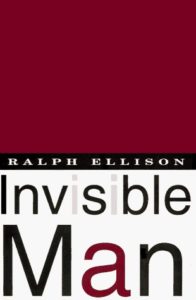 The first-person Invisible Man is an unnamed young black man in the 1950s who recounts his journey from the fog of unknowing to self-awareness. The story is framed in opening and closing scenes by the mature narrator, who lives in an abandoned coal cellar in New York. “I am an invisible man,” he says in the opening line, and the rest of the novel explains how that came to be.
The first-person Invisible Man is an unnamed young black man in the 1950s who recounts his journey from the fog of unknowing to self-awareness. The story is framed in opening and closing scenes by the mature narrator, who lives in an abandoned coal cellar in New York. “I am an invisible man,” he says in the opening line, and the rest of the novel explains how that came to be.
His journey took him from a black college in Georgia to a paint factory in New York, and then to a socialist political organization, and finally to his cellar. Along the way he becomes aware of the different aspects of his invisibility, which are many.
The most obvious sense of his invisibility arises from his blackness. White people do not see black people, or don’t want to, or if they do see them, avert their eyes, or if they must interact with them, do so as master to servant. That is apparent to the young narrator even in his early college days and emphasized to the reader by having him be anonymous throughout the novel.
Yet is it so obvious? In early scenes, the narrator is a driver for a rich white man, a perfect role for invisibility. But the white man is a college benefactor who wants to “do good for your people.” He sees black people. But after the narrator drives the benefactor into the country and accidentally exposes him to impoverished and ignorant blacks, the president of the college expels him for having “exposed” the benefactor to the seamy side of black life, tearing open the cloak of respectable black invisibility.
The narrator leaves school and migrates to New York to seek his fortune but he is ignored by potential employers. As an educated black man he is uniquely invisible, neither an ignorant laborer nor an accomplished businessman, yet still black. He is misperceived on both ends of the spectrum and is located nowhere. Again though, it’s not a simple invisibility, and his letters of recommendation are not what he thought, either.
In the throngs of New York, there are so many people that the narrator feels anonymous and invisible as he roams the streets. Things are more complicated than they seem though. He rents a room from an older black woman who treats him kindly even though he’s behind on the rent. Why would she do that when she doesn’t even know him? Is he invisible to her?
When he gets a job working with a socialist political organization, he is thrilled to be doing something positive to uplift his people. Yet he soon discovers secret political machinations that have nothing to do with his grand speechifying and suddenly he realizes that anyone who works behind the scenes is invisible. Yet the highly visible activist who calls for violence on the streets is later revealed to be just a pawn in a political chess game, actually not as visible as he seems.
At the same time, the narrator discovers a flamboyant preacher, reverend Rinehart, who is highly visible and well-loved by his people, but who is also secretly a pimp and a gambler. He’s visible in each context he operates in but nobody (except the narrator) knows his public personas. The real Rinehart is invisible.
There are many other examples of how the theme of “the invisible man” play out, including the framing pieces describing an anonymous black man living in an abandoned coal cellar. Near the end, the narrator makes the case that invisibility is what everyone desires, even white people, who strive to become invisible through conformity.
Yet paradoxically, and brilliantly, the narrator of the novel is extremely detailed in describing every movement of his soul, every fluttering of his heart, every spasm of his thoughts. From the reader’s perspective, this man is anything but invisible. We occupy the inside of his head for 600 pages, the full landscape of his interiority exposed to us as he describes his “invisibility.”
Many other layers of meaning can be, and have been, mined from this book, from the themes of social history, black identity, economics, politics, symbolism, humor. It’s a complex and moving tale that wears well even after the better part of a century.
Ellison, Ralph (1952/1995). Invisible Man. New York: Vintage/Random (581 pp).
